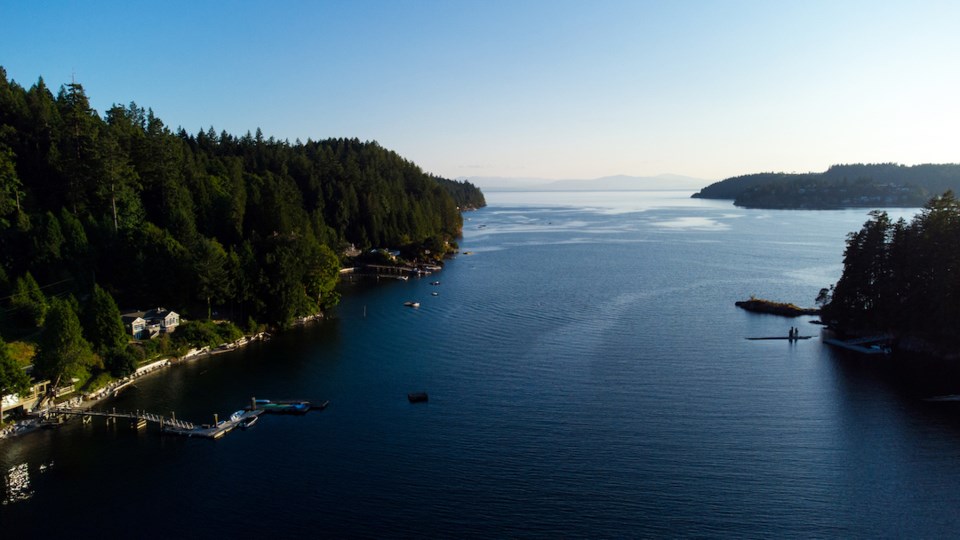A bylaw affecting the rocks and docks of the Keats Island foreshore is making its way through the Islands Trust legislative process.
The Gambier Island Local Trust Committee, whose jurisdiction includes Keats, approved several changes to a proposed Land Use Bylaw amendment as part of the Keats Shoreline Protection Project in a Oct. 31 special meeting.
The shoreline protection project, started in 2018 and now in its third phase, was the result of concerns raised over increased dock development and shore hardening in the environmentally sensitive area. The proposed bylaws are to amend the Keats Island Official Community Plan (OCP) and the Land Use Bylaw (LUB) to address inconsistencies and provide better protection of the marine areas around Keats Island.
Draft bylaw 154 proposes amendments to the LUB, to align the bylaw with actual conditions on the island, based on concerns raised by island residents. The local trust committee is in the process of giving a revised second reading to this proposed amendment bylaw.
Issues raised among residents include that proposed new dock regulations are impractical for smaller waterfront lots, that the proposed development permit requirement is overly broad and that the Trust should work collaboratively with residents to implement effective and environmentally sound shoreline protection measures.
Dock sizing
The first motion passed Oct. 31 addressed an inconsistency in the bylaw that would allow for larger residential docks to be built in one zone of the island.
Currently, the Private Institutional 2(PI2) zone allows for a larger residential dock than the surrounding zones, Community Residential 1(CR1), Rural Residential (RR), and Moorage sub-zone M2(a). Although no residential homes or docks are in this zone, homes may eventually be built in the area.
Trustee Joe Bernardo put forward a motion that the proposed bylaw be amended so as to make the dock lengths and uses allowed in PI2 more uniform with surrounding zones, a motion that passed unanimously.
While the LUB allowed for residential docks in the P12 zone, there was no legislation in regard to dock sharing, width of access ramps and infrastructure like piers. A second proposed motion passed aligns this zone’s regulations with that of surrounding zones.
The committee also addressed an inconsistency in the bylaw draft that would reduce the allowable dock size at the Barnabas campground to 1,500 square metres, while allowing the dock at Keats camp to remain at 3,000 square metres.
In order to remain consistent, the committee resolved that proposed Bylaw 154 be amended to reduce the maximum coverage area for institutional dock facilities in the M2(b) zone to the same 1,500 square metre limit contemplated for the P12 zone.
“What we're doing is bringing our bylaws into conformity with federal legislation,” said Bernardo.
Dock sharing
The committee also passed a motion to allow for larger docks when shared with a higher number of dwellings for the purpose of incentivizing dock sharing.
Currently, residential docks within the CR1, RR, RC and M2(a) zones have a maximum size of 47 square metres, and for each additional dwelling sharing the dock an additional 30 square metres can be added to the float, up to a maximum size of 105 square metres.
Bernardo stated that most boats need at least five metres, which sets the limit of dock sharing to four residences.
The Island Trust agenda package stated that, “The scientific rationale for that policy is that the shadow cast by dock floats on the seafloor can have a negative effect on the marine habitat. Of particular concern is that shading inhibits the growth of sea grasses that provide foraging areas and spawning surfaces for a variety of fish and invertebrate species.”
In order to incentivize dock sharing, trustee Bernardo proposed increasing the allowed initial size of a shared residential dock from 47 square metres to 77, still allowing 30 additional square metres per additional dwelling, up to a maximum of 154 square metres.
He pointed out that fewer, larger docks have a smaller environmental impact than having multiple small docks.
The motion passed unanimously.
To be concluded
Due to the nature of the discussion, the committee exceeded the set time for the special meeting, and had to schedule a time to conclude the items being discussed before it can receive second reading and have a public hearing. Since additional time is needed to go through the motions, the public hearing has been deferred until 2024, and a regular meeting will be held on Nov. 21 for trustees to complete their assessment of the proposed amendments.
Bylaws created by the Island Trust are sent to the Ministry of Municipal Affairs for final approval before they are set in place.
Jordan Copp is the Coast Reporter’s civic and Indigenous affairs reporter. This reporting beat is made possible by the Local Journalism Initiative.



